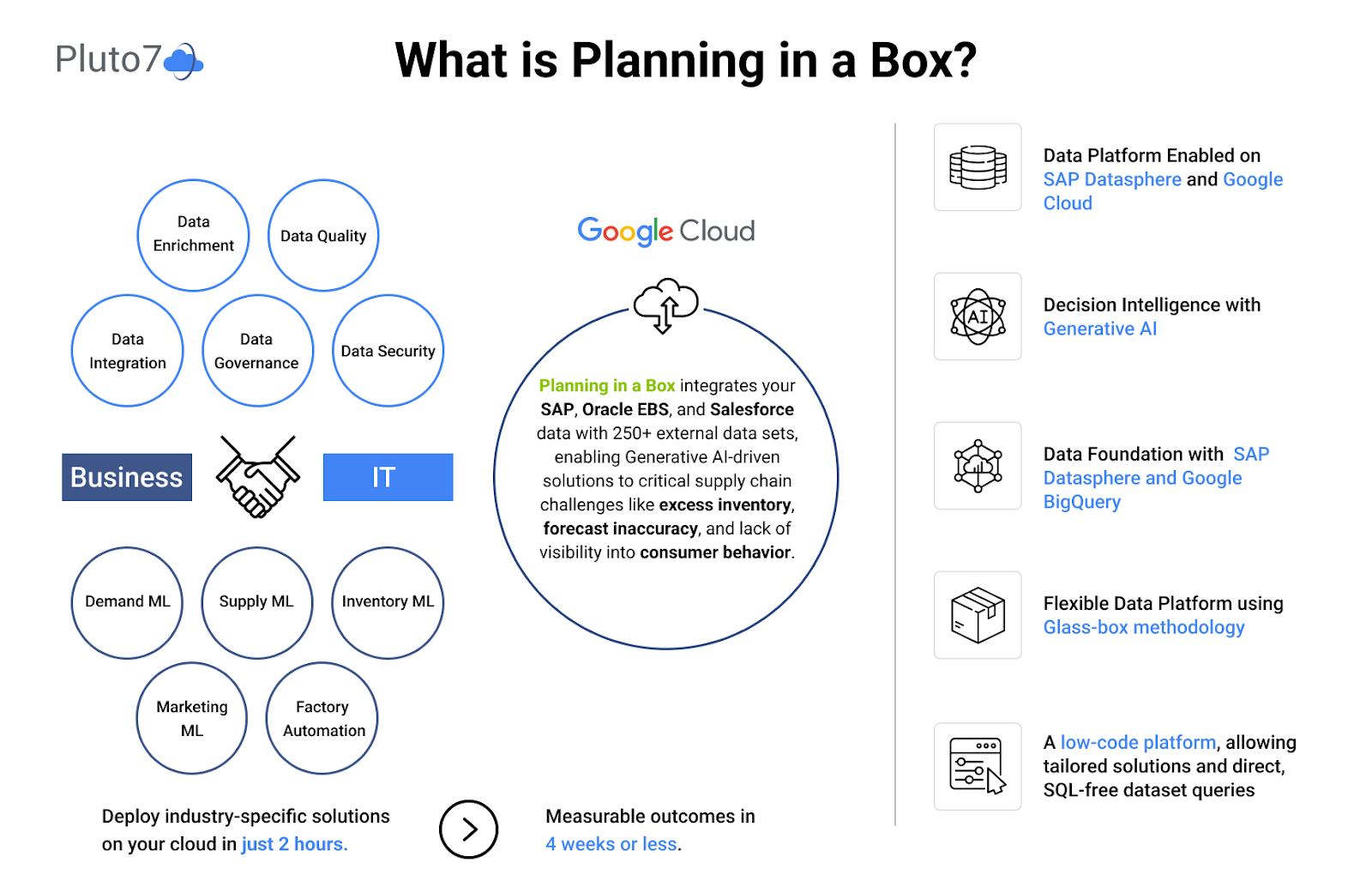
Transform Your Supply Chain Planning and Marketing Strategies with Google Cloud and SAP Integration

Transform Your Supply Chain Planning and Marketing Strategies with Google Cloud and SAP Integration
December 7, 2023 | Asheesh Gupta
Blog / Why SAP Users Should Consider BigQuery for Supply Chain Data Analytics
Supply chain management, a critical component of modern business operations, especially in sectors like manufacturing, retail, and logistics, has always been data-intensive. Traditionally, organizations have relied on systems like SAP Business Warehouse (SAP BW) to handle this data. However, as the complexity and volume of supply chain data grow exponentially, SAP users face new challenges. These challenges include integrating disparate data sources, scaling data infrastructure to meet increasing demands, and leveraging advanced analytics for deeper insights. This is where Google Cloud’s BigQuery presents itself as a transformative solution, offering a robust, scalable, and efficient data warehousing platform tailored for the intricate needs of supply chain management.
The complexity of supply chain management today demands not only the collection of vast amounts of data but also the ability to quickly analyze and act upon this data. Here’s a closer look at key supply chain analytics challenges and how BigQuery’s capabilities offer significant improvements over traditional data analytics tools:
| Supply Chain Analytical Needs | Limitations of Traditional Data Analytics | How BigQuery Addresses These Challenges |
|---|---|---|
| Real-Time Inventory Management | Slower data processing leads to outdated inventory insights. | Provides real-time data processing for up-to-the-minute inventory tracking. |
| Demand Forecasting Accuracy | Limited in handling large datasets, affecting forecast precision. | Utilizes machine learning for more accurate and granular demand predictions. |
| Supplier Performance Analysis | Difficulty integrating external data sources for a complete supplier view. | Seamlessly integrates diverse data sources for comprehensive supplier evaluations |
| Distribution Network Optimization | Struggles with complex data sets needed for optimizing distribution routes. | Offers advanced analytics to optimize routes and reduce logistics costs. |
| Risk Mitigation in Supply Chain Disruptions | Inadequate in predictive capabilities to foresee and plan for disruptions. | Employs predictive analytics to identify potential risks and suggest proactive measures. |
| Compliance and Regulatory Reporting | Time-consuming report generation, leading to delays in compliance. | Accelerates reporting processes, ensuring timely compliance with regulations. |
| Customer Satisfaction and Feedback Analysis | Limited in analyzing unstructured customer feedback data. | Analyzes large volumes of unstructured data to derive customer insights and improve satisfaction. |
| Cost Reduction and Efficiency Improvement | Inefficient in identifying areas of cost savings and operational inefficiencies. | Leverages AI to pinpoint inefficiencies and suggest cost-saving strategies. |

ACME Retail, a leader in the handbag industry, faces significant challenges in adapting its supply chain to rapidly changing market conditions and consumer sentiments. Despite utilizing SAP’s robust systems for supply chain management, ACME struggles with gaining real-time supply chain visibility, quickly adjusting inventory to shifting consumer demands, and tapping into rising consumer sentiments effectively.
ACME Retail uses SAP Advanced Planner and Optimizer (SAP APO) for demand planning.
SAP APO forecasts are based on historical sales data, promotional calendars, and market analysis.
While SAP APO provides a baseline for demand planning, it may not quickly adapt to sudden market shifts.
ACME relies on SAP ERP Central Component (ECC) for inventory management and day-to-day transaction processing.
SAP ECC struggles with real-time inventory adjustments, resulting in either overstocking or stock shortages, especially during sudden demand shifts.

Planning in a Box is a decision intelligence platform developed by Pluto7, designed to make data analytics simpler and transform the way businesses make decisions. It leverages the power of Generative AI to analyze, interpret, and provide insights from vast arrays of data in an intuitive, user-friendly manner.
We assist in harnessing BigQuery’s advanced features like ML integration and real-time analytics, ensuring they are effectively applied to supply chain scenarios. With Planning in a Box, you get custom AI and ML models that work seamlessly with BigQuery, offering predictive insights tailored to the nuances of your supply chain. These models enable more accurate forecasting, risk mitigation, and efficiency improvements, directly impacting your bottom line.
By choosing Pluto7, SAP users can leverage the power of BigQuery not just as a standalone solution but as part of a comprehensive, business-focused strategy. Join us to transform your supply chain analytics and make the leap into a future where data drives not just insights, but actionable, impactful business decisions.
ABOUT THE AUTHOR